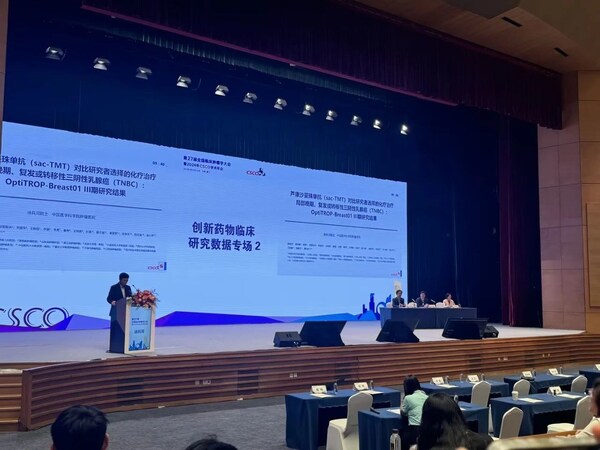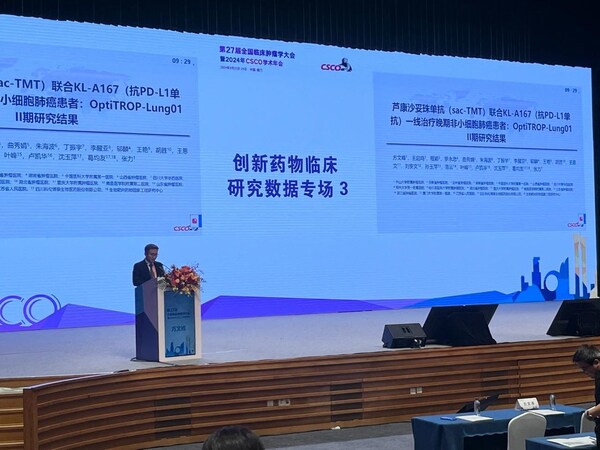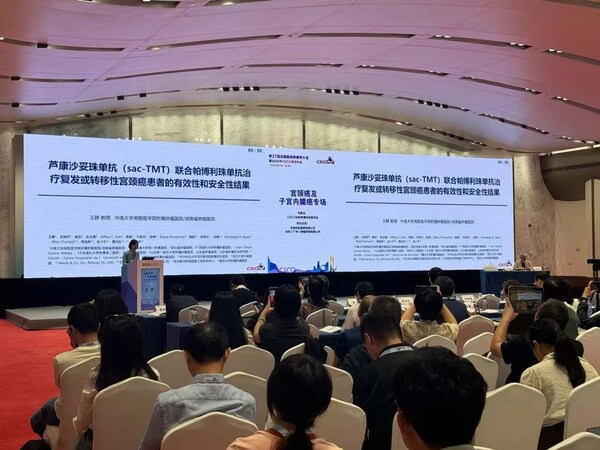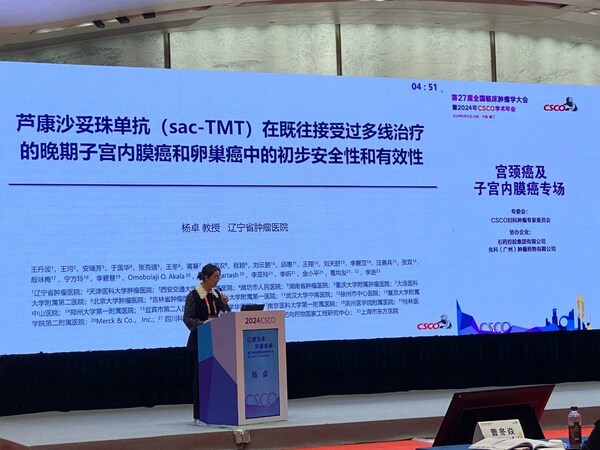CHENGDU, China, Sept. 29, 2024 /PRNewswire/ -- From September 25th to 29th, the 27th China Clinical Oncology Congress and the 2024 CSCO Annual Meeting were held in Xiamen. Experts and scholars in the field of oncology from all over China gathered together to discuss the hotspots at the forefront of clinical practice. Sichuan Kelun-Biotech Biopharmaceutical Co., Ltd. ("Kelun-Biotech", 6990.HK) presented multiple clinical research results and progress of TROP2 ADC sacituzumab tirumotecan (sac-TMT, formerly SKB264/MK-2870) at the conference.
TNBC
On the afternoon of September 27, Academician Binghe Xu from the Cancer Hospital of the Chinese Academy of Medical Sciences gave an oral presentation and paper discussion on the results of the Phase III OptiTROP-Breast01 study of sacituzumab tirumotecan (sac-TMT) in patients (pts) with previously treated locally recurrent or metastatic triple-negative breast cancer (TNBC) in the Innovative Drugs Clinical Data Session.
The median PFS assessed by BICR was 6.7 months (95% CI, 5.5 to 8.0) with SKB264 and 2.5 months (95% CI, 1.7 to 2.7) with chemotherapy; The sac-TMT group had a 68% reduction in risk of disease progression or death compared to the chemotherapy group (HR 0.32; 95% CI, 0.22 to 0.44; P <0.00001). In the subset of pts with TROP2 H-score > 200, the median PFS was 8.3 months with SKB264 and 2.3 months with chemotherapy (HR 0.29; 95% CI, 0.19 to 0.46). The median OS was not reached (95% CI, 11.2 to NE) with SKB264 and 9.4 months (95% CI, 8.5 to 11.7) with chemotherapy. The sac-TMT group had a 47% reduction in risk of death compared to the chemotherapy group (HR 0.53; 95% CI, 0.36 to 0.78; P =0.00005). Compared to the investigator's choice of chemotherapy, sac-TMT for metastatic TNBC patients showed statistically and clinically significant improvements in PFS and OS, with a manageable safety profile, and could be a new and effective therapeutic option for this group of patients.
Binghe Xu said, "Breast cancer is a highly prevalent malignant tumor in the world, threatening women's lives and health, among which, triple-negative breast cancer is also known as 'the most toxic' breast cancer due to its poor therapeutic effect. The future direction of advanced triple-negative breast cancer treatment is precise and stratified treatment. Sac-TMT can help to meet more treatment needs of patients, and may be expected to become the new standard of second-line treatment for advanced triple-negative breast cancer in the future. For the research and development of ADC, domestic enterprises have gone through the stages of catching up and running parallel to each other, and now they have become an important force in the global ADC innovation technology, and we believe that one day, patients with advanced triple-negative breast cancer can get more effective treatment through ADC innovative drugs."
NSCLC
On the afternoon of September 28, Prof. Wenfeng Fang from the Affiliated Cancer Hospital of Sun Yat-sen University orally reported the results of the Phase II OptiTROP-Lung01study, a first-line treatment for patients with advanced non-small-cell lung cancer (NSCLC) with sac-TMT in combination with KL-A167, an anti-PD-L1 monoclonal antibody, in the session of Clinical Data of Innovative Drugs, with a paper discussion.
Pts with treatment naive advanced NSCLC without actionable genomic alterations were enrolled to receive SKB264 5 mg/kg Q3W + KL-A167 1200 mg Q3W (cohort 1A,130 Pts) or SKB264 5 mg/kg Q2W + KL-A167 900 mg Q2W (cohort 1B,133 Pts) in a non-randomized manner. After median follow up of 14.0 mo and 6.9 mo for cohort 1A and 1B, the ORR was 48.6% (18/37, 2 pending confirmation), DCR was 94.6% and median PFS was 15.4 mo (95% CI: 6.7, NE) with 6-mo PFS rate of 69.2% for cohort 1A ; the ORR was 77.6% (45/58, 5 pending confirmation), DCR was 100% and median PFS was not reached with 6-mo PFS rate of 84.6% for cohort 1B.
Prof. Wenfeng Fang said, "The emergence of ADC drugs is epoch-making. The dual-drug regimen of sac-TMT combined with immunotherapy is leading a new direction in the exploration of first-line treatment for advanced NSCLC, with very stunning efficacy observed in the preliminary study data. In the future, the potential for the application of sac-TMT in the treatment of NSCLC is worth looking forward to, and sac-TMT is expected to provide diversified treatment options and better survival benefits for more patients, both in the driver-negative and EGFR-mutated patient populations."
CC
On the morning of September 28, Professor Jing Wang from Hunan Cancer Hospital orally reported the results of Efficacy and Safety of sac-TMT Plus Pembrolizumab in patients with recurrent or metastatic cervical cancer. Pts with R/M CC who had progressed on or after platinum-doublet chemotherapy and received no more than 2 systemic therapies for R/M disease were enrolled.38 pts were treated and followed up for at least 17 weeks or 2 tumor assessments. The median follow-up was 6.2 mo, The ORR was 57.9% (22/38, 3 unconfirmed), with 3 complete responses. Responses were also observed in pts were pre-treated with anti-PD-1 based therapy. Median PFS was not reached and 6-mo PFS rate was 65.7%.
Professor Jing Wang said, "Cervical cancer highly expresses TROP2, and previous studies have suggested that the overexpression ratio is more than 90%. High TROP2 expression is closely related to the poor prognosis of tumor patients, and it may also be related to the sensitivity of some drug therapies, which makes it a good target to explore. It is believed that with these promising results, more studies will emerge in the field of gynecologic oncology in the future to further validate these findings and bring hope to a wider range of cancer patients."
EC/OC
On the morning of September 28, Dr. Zhuo Yang from Liaoning Provincial Cancer Hospital shared the results of safety and efficacy of sac-TMT in pts with previously treated advanced endometrial carcinoma (EC) and ovarian cancer (OC) from a Phase 2 Study. In the endometrial cancer cohort, 44 EC pts were enrolled and median follow-up time was 7.2 mo. 52.3% of pts had received ≥ 2 prior lines of therapy. The ORR was 34.1% (15/44, 12 confirmed) and DCR was 75%. Median PFS was 5.7 mo (95% CI: 3.7, 9.4) with 6-mo PFS rate of 47.5%.
40 OC pts were enrolled and median follow-up time was 28.2 mo. All pts had received ≥ 2 prior lines of therapy (80% of pts ≥ 3 prior lines). 87.5% of pts were platinum-resistant. The ORR was 40% (16/40, 14 confirmed) and DCR was 75%. mPFS was 6.0 mo (95% CI: 3.9, 7.3); mo was 16.5 mo (95% CI: 10.7, NE). In the pts with TROP2 IHC H-score > 200 (n=13) or H-score ≤ 200 (n=22), the ORR was 61.5% (8/13, 7 confirmed) and 27.3% (6/22, 6 confirmed) respectively. In the pts with platinum-resistant (n=35), mPFS was 6.0 mo (95% CI: 5.3, 7.3) and mOS was 16.1 mo (95% CI: 10.5, NE).
Prof Danbo Wang said, "Ovarian cancer and endometrial cancer have their own epidemiological characteristics, and the incidence rate of endometrial cancer in developed cities in China is increasing year by year, and it may become the top gynecological malignant tumor in Chinese women in the future. In contrast, ovarian cancer is characterized by insidious onset, high late detection rate and high mortality rate. Exploring new therapeutic strategies to overcome platinum resistance and improve the survival rate of ovarian cancer patients is a key direction for future research. Sac-TMT shows great potential in the treatment of advanced endometrial and ovarian cancers. It has not only achieved remarkable results in terms of efficacy, but also well controlled safety. I believe that in the future research and application, it will become a leader in the field of ADC innovative drug development and bring new hope to more gynecological oncology patients."
With a caring heart, Kelun-Biotech is committed to solving unmet clinical needs in China and around the world. By focusing on its own technological strengths, Kelun-Biotech is able to provide patients in China with novel ADC drugs with significant clinical value and excellent cost-effectiveness, and to enhance the benefits for clinical patients. In the future, we will continue to accelerate the R&D and clinical progress of our drug candidates, enhance our integrated drug development capabilities, and contribute to the realization of Healthy China 2030.
source: Sichuan Kelun-Biotech Biopharmaceutical Co., Ltd.
【你點睇?】媒體近日報道有關愛隊涉活動造假或誇大以滿足KPI,事件會否影響你對關愛隊的印象?► 立即投票


































